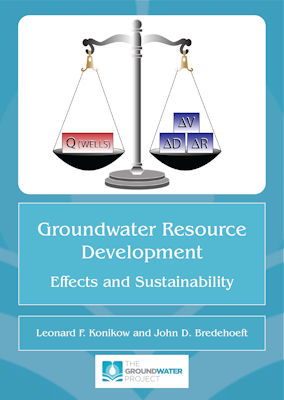Groundwater withdrawals expanded dramatically during the last half of the 20th century. Approximately half the population of the world depends upon groundwater for its drinking water supply, and groundwater supplies almost half of the water used for irrigation in agricultural areas. This large and expanding use of groundwater is the primary driving force for concerns about groundwater (aquifer) depletion and sustainability of groundwater pumping.
When a water-supply well is drilled, it is usually with the hope that the well will reliably provide water for a long time (that is, its use will be sustainable for future generations). This book presents the principles associated with development of groundwater at the macro scale. These ideas date back to a classic paper by C.V. Theis in 1940 on the source of water derived from wells, in which he noted that all pumpage is balanced by a loss of water somewhere, with the loss during early times coming largely from aquifer storage and at later times increasingly from capture, which includes increases in recharge and decreases in discharge (such as base flow to streams and evapotranspiration).
Groundwater is often characterized as a “renewable resource.” Yet data now accumulating indicate that much of the current development of groundwater is depleting the resource at rates that cannot be sustained — in many places groundwater is being “mined” at high rates — contradicting its renewability over human timeframes. This poses a challenge to groundwater scientists and managers — can the resource be developed in a sustainable manner, and if so, how can that goal be accomplished?
The desirability and value of sustainable development of groundwater is clear. If the groundwater storage depletion over time becomes negligible, then groundwater withdrawals are maintainable indefinitely (as long as other factors do not affect the aquifer’s water balance). But “sustainability” should be assessed in a larger perspective than just whether pumping can continue indefinitely — the assessment should include impacts on surface-water flows, other environmental consequences (e.g., land subsidence and water-quality changes), as well as other linkages, such as socio-economics.
Hydrogeologists have the knowledge and tools to understand and predict the magnitude and timing of these effects. The most effective tool is a well-calibrated numerical simulation model, through which hydrogeologists can develop understanding and quantitative assessments of complex aquifer systems. Thereby, hydrogeologists can provide predictive understanding, which offers a long-view scientific basis for policy makers and water managers to make sound and defensible policy decisions.

